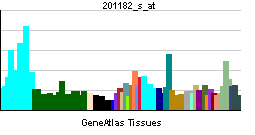CHD4
| Chromodomain helicase DNA binding protein 4 | |||||||||||||
|---|---|---|---|---|---|---|---|---|---|---|---|---|---|
 PDB rendering based on 1mm2. | |||||||||||||
| |||||||||||||
| Identifiers | |||||||||||||
| Symbols | CHD4 ; DKFZp686E06161; Mi-2b; Mi2-BETA | ||||||||||||
| External IDs | Template:OMIM5 Template:MGI HomoloGene: 68175 | ||||||||||||
| |||||||||||||
| RNA expression pattern | |||||||||||||
 | |||||||||||||
 | |||||||||||||
 | |||||||||||||
| More reference expression data | |||||||||||||
| Orthologs | |||||||||||||
| Template:GNF Ortholog box | |||||||||||||
| Species | Human | Mouse | |||||||||||
| Entrez | n/a | n/a | |||||||||||
| Ensembl | n/a | n/a | |||||||||||
| UniProt | n/a | n/a | |||||||||||
| RefSeq (mRNA) | n/a | n/a | |||||||||||
| RefSeq (protein) | n/a | n/a | |||||||||||
| Location (UCSC) | n/a | n/a | |||||||||||
| PubMed search | n/a | n/a | |||||||||||
Chromodomain helicase DNA binding protein 4, also known as CHD4, is a human gene.[1]
The product of this gene belongs to the SNF2/RAD54 helicase family. It represents the main component of the nucleosome remodeling and deacetylase complex and plays an important role in epigenetic transcriptional repression. Patients with dermatomyositis develop antibodies against this protein.[1]
References
Further reading
- Denslow SA, Wade PA (2007). "The human Mi-2/NuRD complex and gene regulation". Oncogene. 26 (37): 5433–8. doi:10.1038/sj.onc.1210611. PMID 17694084.
- Ge Q, Nilasena DS, O'Brien CA; et al. (1995). "Molecular analysis of a major antigenic region of the 240-kD protein of Mi-2 autoantigen". J. Clin. Invest. 96 (4): 1730–7. PMID 7560064.
- Seelig HP, Moosbrugger I, Ehrfeld H; et al. (1995). "The major dermatomyositis-specific Mi-2 autoantigen is a presumed helicase involved in transcriptional activation". Arthritis Rheum. 38 (10): 1389–99. PMID 7575689.
- Seelig HP, Renz M, Targoff IN; et al. (1996). "Two forms of the major antigenic protein of the dermatomyositis-specific Mi-2 autoantigen". Arthritis Rheum. 39 (10): 1769–71. PMID 8843877.
- Woodage T, Basrai MA, Baxevanis AD; et al. (1997). "Characterization of the CHD family of proteins". Proc. Natl. Acad. Sci. U.S.A. 94 (21): 11472–7. PMID 9326634.
- Zhang Y, LeRoy G, Seelig HP; et al. (1998). "The dermatomyositis-specific autoantigen Mi2 is a component of a complex containing histone deacetylase and nucleosome remodeling activities". Cell. 95 (2): 279–89. PMID 9790534.
- Tong JK, Hassig CA, Schnitzler GR; et al. (1998). "Chromatin deacetylation by an ATP-dependent nucleosome remodelling complex". Nature. 395 (6705): 917–21. doi:10.1038/27699. PMID 9804427.
- Zhang Y, Ng HH, Erdjument-Bromage H; et al. (1999). "Analysis of the NuRD subunits reveals a histone deacetylase core complex and a connection with DNA methylation". Genes Dev. 13 (15): 1924–35. PMID 10444591.
- Schmidt DR, Schreiber SL (1999). "Molecular association between ATR and two components of the nucleosome remodeling and deacetylating complex, HDAC2 and CHD4". Biochemistry. 38 (44): 14711–7. PMID 10545197.
- Humphrey GW, Wang Y, Russanova VR; et al. (2001). "Stable histone deacetylase complexes distinguished by the presence of SANT domain proteins CoREST/kiaa0071 and Mta-L1". J. Biol. Chem. 276 (9): 6817–24. doi:10.1074/jbc.M007372200. PMID 11102443.
- Andersen JS, Lyon CE, Fox AH; et al. (2002). "Directed proteomic analysis of the human nucleolus". Curr. Biol. 12 (1): 1–11. PMID 11790298.
- Koipally J, Georgopoulos K (2002). "A molecular dissection of the repression circuitry of Ikaros". J. Biol. Chem. 277 (31): 27697–705. doi:10.1074/jbc.M201694200. PMID 12015313.
- Saito M, Ishikawa F (2002). "The mCpG-binding domain of human MBD3 does not bind to mCpG but interacts with NuRD/Mi2 components HDAC1 and MTA2". J. Biol. Chem. 277 (38): 35434–9. doi:10.1074/jbc.M203455200. PMID 12124384.
- Strausberg RL, Feingold EA, Grouse LH; et al. (2003). "Generation and initial analysis of more than 15,000 full-length human and mouse cDNA sequences". Proc. Natl. Acad. Sci. U.S.A. 99 (26): 16899–903. doi:10.1073/pnas.242603899. PMID 12477932.
- Hakimi MA, Dong Y, Lane WS; et al. (2003). "A candidate X-linked mental retardation gene is a component of a new family of histone deacetylase-containing complexes". J. Biol. Chem. 278 (9): 7234–9. doi:10.1074/jbc.M208992200. PMID 12493763.
- Kwan AH, Gell DA, Verger A; et al. (2004). "Engineering a protein scaffold from a PHD finger". Structure. 11 (7): 803–13. PMID 12842043.
- Shimono Y, Murakami H, Kawai K; et al. (2004). "Mi-2 beta associates with BRG1 and RET finger protein at the distinct regions with transcriptional activating and repressing abilities". J. Biol. Chem. 278 (51): 51638–45. doi:10.1074/jbc.M309198200. PMID 14530259.
- Ota T, Suzuki Y, Nishikawa T; et al. (2004). "Complete sequencing and characterization of 21,243 full-length human cDNAs". Nat. Genet. 36 (1): 40–5. doi:10.1038/ng1285. PMID 14702039.
- Williams CJ, Naito T, Arco PG; et al. (2004). "The chromatin remodeler Mi-2beta is required for CD4 expression and T cell development". Immunity. 20 (6): 719–33. doi:10.1016/j.immuni.2004.05.005. PMID 15189737.
- Lehner B, Sanderson CM (2004). "A protein interaction framework for human mRNA degradation". Genome Res. 14 (7): 1315–23. doi:10.1101/gr.2122004. PMID 15231747.
| This protein-related article is a stub. You can help Wikipedia by expanding it. |